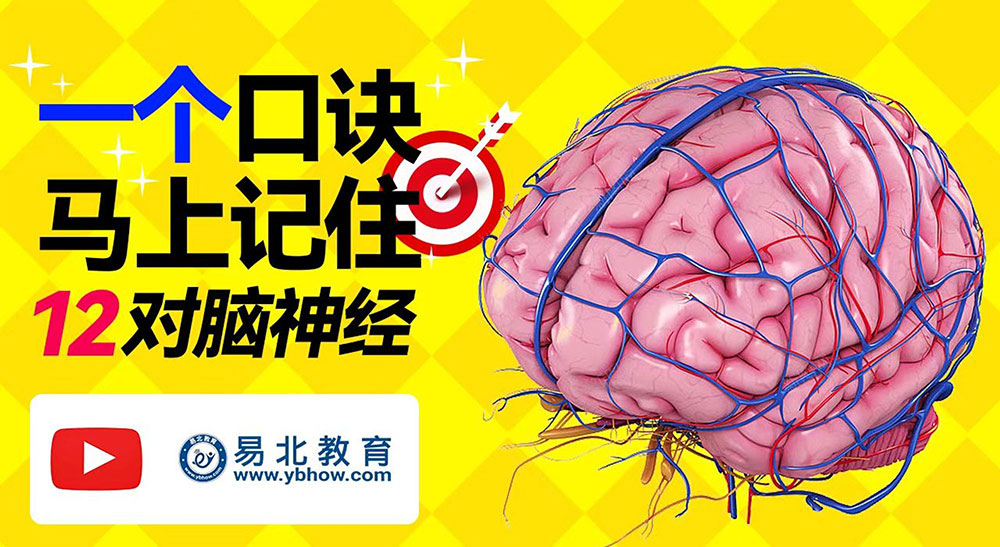1. Smell 2. Sight 3. Eye movement
4 slide 5 fork 6 abduction
7 face 8 listen 9 tongue swallow
0 fans 1 pair of sublingual full
12 pairs of cranial nerves under complete control!
Hello everyone, I am Teacher Xu from Yibei Education.
The above few tips are actually what Yibei Education teaches everyone in the MBLEx training course : a simple way to easily remember the 12 pairs of cranial nerves!
Students who have not studied the course may be confused at first glance. Don’t worry, today I will use simple and easy-to-understand language to explain in detail the characteristics and functions of these 12 pairs of cranial nerves, and will also use MBLEx test questions to demonstrate to you how to flexibly apply these knowledge points in the MBLEx exam!
I believe that the following explanation will give you a deeper understanding of the formula at the beginning of the article, and will also enable you to more easily master the high-frequency test points of MBLEx – 12 pairs of cranial nerves!
If you prefer a video version, you can click to watch our YouTube video: How to quickly remember the 12 pairs of cranial nerves?
Okay, let’s start today’s sharing right away!
The names and functions of the 12 pairs of cranial nerves are an important topic in the MBLEx exam and belong to the section “Nerves” in Chapter 1, “Anatomy and Function”.
What are nerves? Simply put, human nerves are like network cables, responsible for transmitting the brain’s commands to the various organs of the body; conversely, they can also transmit the feelings of various organs back to the brain.
There are 12 pairs of cranial nerves in the human body, numbered with Roman numerals. These nerves mainly control sensation and movement in the head and neck, and each pair of nerves is associated with a specific sensory or motor function.
Here is a brief introduction to the 12 pairs of cranial nerves:
1. Olfactory nerve (I): mainly responsible for the sense of smell.
2. Optic nerve (II): mainly responsible for vision.
3. Oculomotor nerve (III): controls most eye movements.
4. Trochlear nerve (IV): controls the movement of the eyeball inward and downward.
5. Trigeminal nerve (V): This is the main sensory nerve to the head and face, and also controls the movement of the chewing muscles.
6. Abducens nerve (VI): controls the outward movement of the eyeball.
7. Facial nerve (VII): responsible for controlling the movement of facial muscles, facial expressions and oral control.
8. Vestibulocochlear nerve (VIII): mainly responsible for hearing and balance.
9. Glossopharyngeal nerve (IX): mainly responsible for taste, throat sensation and helping swallowing.
10. Vagus nerve (X): This is a very important nerve that provides connections between the brain and many organs in the body, including the heart, lungs, stomach, and other digestive tract organs.
11. Accessory nerve (XI): Controls certain muscles in the neck and shoulders.
12. Hypoglossal nerve (XII): controls the movement of the tongue.
With so many professional words and corresponding functions, if you memorize them by rote, you will never be able to memorize them even if you memorize them forever! So, how can you quickly memorize these 12 pairs of cranial nerves? At this time, you need to use the “mnemonics” mentioned at the beginning of our video:
1. Smell 2. Sight 3. Eye movement
4 slide 5 fork 6 abduction
7 face 8 listen 9 tongue swallow
10 fans 1 sublingual full
Let’s look at it sentence by sentence:
“1 smell 2 sight 3 eye movement”
It actually means:
Ⅰ Olfactory nerve
Ⅱ Optic nerve
III Oculomotor nerve
Among them:
[olfactory nerve] and [optic nerve] belong to [sensory nerve]
[oculomotor nerve] belongs to [motor nerve]
“4 slides 5 forks 6 abductions”
The “4 slides” are the trochlear nerves, which control the movement of the eyeball inward and downward.
“5th fork”, [trigeminal nerve], belongs to the “mixed nerve”
“6 Abducens” refers to the abducens nerve, which controls the outward movement of the eyeball.
The trochlear nerve and the abducens nerve are motor nerves.
“7 faces 8 listening 9 tongue swallowing”
“7 faces”, facial nerve, controls the movement of facial expression muscles
“8 Listening”, vestibulocochlear nerve, mainly responsible for hearing and balance
“9 Glossopharyngeal”, the glossopharyngeal nerve, mainly responsible for taste, throat sensation and helping swallowing
By function:
The vestibulocochlear nerve is responsible for balance and hearing and is a sensory nerve.
The facial nerve and glossopharyngeal nerve are mixed nerves.
“10 fans, 1 sublingual full”
10. Vagus nerve
1st, XI, accessory nerve, controls certain muscles in the neck and shoulders
Hypoglossal nerve, XII, controls the movement of the tongue
1. Smell 2. Sight 3. Eye movement
4 slide 5 fork 6 abduction
7 face 8 listen 9 tongue swallow
10 fans 1 sublingual full
Through these four short mnemonics, we can easily remember the 12 pairs of cranial nerves in the human body. Isn’t it efficient?
Now that we have the knowledge points in mind, let’s take a look at how the questions are tested:
【MBLEx Exam Question Analysis】
Which of the following pairs of cranial nerves innervates facial movement?
cranial nerves
facial movement
Which of the following pairs of cranial nerves innervate facial movement?
A. IV
B. Ⅴ
C. VI
D. VII
The correct answer is D. Ⅶ, the seventh pair
【Exam Question Analysis】
We have introduced the 12 pairs of cranial nerves in detail earlier, and you know that these cranial nerves are numbered with Roman numerals.
The question asks, “Which pair of cranial nerves control facial movements?” The ones that control facial movements are naturally the facial nerves. Which pair of nerves are the facial nerves?
Let’s recall the formula together:
1. Smell 2. Sight 3. Eye movement
4 slide 5 fork 6 abduction
7 face 8 listen 9 tongue swallow
10 fans 1 sublingual full
7 faces, which means the seventh pair of cranial nerves
Therefore, the correct answer is to choose the Roman numeral Ⅶ
How about it? After understanding the knowledge points, using these formulas, can you quickly master the 12 pairs of cranial nerves? If you encounter questions about cranial nerves in the MBLEx exam, no matter which pair of cranial nerves it tests, we can answer them easily!
Yibei uses such a simple and effective learning method to explain the MBLEx knowledge points and test questions to students in an easy-to-understand manner, and then combines it with keyword cards and pre-test simulations, so that so many Chinese students with no English foundation can pass the MBLEx exam easily and quickly!
If you are still worried about the MBLEx exam, you might as well register for an Elbe account for free and experience our 7-day free trial course for yourself!
If you have any questions about the MBLEx U.S. Federal Massage Exam or the knowledge points of these 12 pairs of cranial nerves, you can directly add Teacher Xu on WeChat ybmblex or call (702) 892-7688. We will answer your questions!


